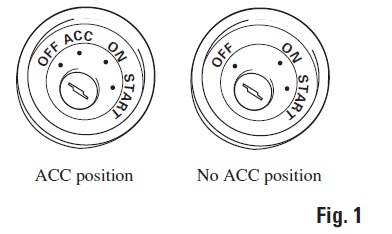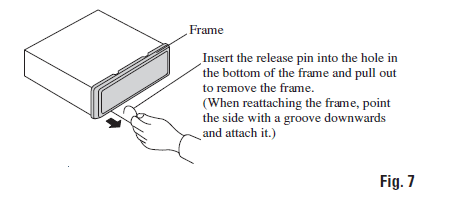
Pioneer DEH-1500 High Power CD Player

Connecting the Units
Note
- This unit is for vehicles with a 12-volt battery and negative grounding. Before installing it in a recreational vehicle, truck or bus, check the battery voltage.
- To avoid shorts in the electrical system, be sure to disconnect the ≠ battery cable before beginning installation.
- Refer to the owner’s manual for details on connecting the power amp and other units, then make connections correctly.
- Secure the wiring with cable clamps or adhesive tape. To protect the wiring, wrap adhesive tape around them where they lie against metal parts.
- Route and secure all wiring so it cannot touch any moving parts, such as the gear shift, handbrake and seat rails. Do not route wiring in places that get hot, such as near the heater outlet. If the insulation of the wiring melts or gets torn, there is a danger of the wiring short-circuiting to the vehicle body.
- Don’t pass the yellow lead through a hole into the engine compartment to connect to the battery. This will damage the lead insulation and cause a very dangerous short.
- Do not shorten any leads. If you do, the protection circuit may fail to work when it should.
- Never feed power to other equipment by cutting the insulation of the power supply lead of the unit and tapping into the lead. The current capacity of the lead will be exceeded, causing overheating.
- When replacing fuse, be sure to use only fuse of the rating prescribed on this unit.
- Since a unique BPTL circuit is employed, never wire so the speaker leads are directly grounded or the left and right ≠ speaker leads are common. If you ground the products together and the ground becomes detached, there is a risk of damage to the products or fire.
- The black lead is ground. Please ground this lead separately from the ground of high-current products such as power amps. If you ground the products together and the ground becomes detached, there is a risk of damage to the products or fire.
- Speakers connected to this unit must be high power types with minimum rating of 50 W and impedance of 4 to 8 ohms. Connecting speakers with output and/or impedance values other than those noted here may result in the speakers catching fire, emitting smoke, or becoming damaged.
- When this product’s source is switched ON, a control signal is output through the blue/white lead. Connect to an external power amp’s system remote control or the car’s Auto-antenna relay control terminal (max. 300 mA 12 V DC). If the car features a glass antenna, connect to the antenna booster power supply terminal.
- When an external power amp is being used with this system, be sure not to connect the blue/white lead to the amp’s power terminal. Likewise, do not connect the blue/white lead to the power terminal of the auto-antenna. Such connection could cause excessive current drain and malfunction.
- To avoid short-circuiting, cover the disconnected lead with insulating tape. Especially, insulate the unused speaker leads without fail. There is a possibility of short-circuiting if the leads are not insulated.
- If this unit is installed in a vehicle that does not have an ACC (accessory) position on the ignition switch, the red lead of the unit should be connected to a terminal coupled with ignition switch ON/OFF operations. If this is not done, the vehicle battery may be drained when you are away from the vehicle for several hours. (Fig. 1)

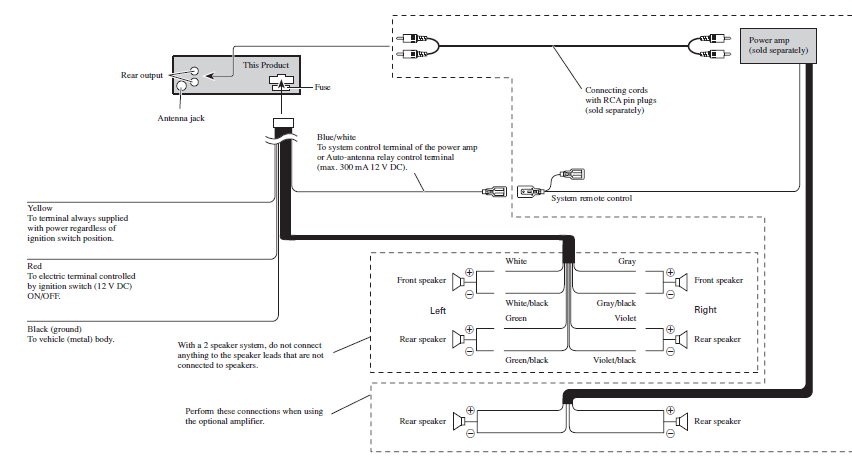
Installation
Note
- Before finally installing the unit, connect the wiring temporarily, making sure it is all connected up properly, and the unit and the system work properly.
- Use only the parts included with the unit to ensure proper installation. The use of unauthorized parts can cause malfunctions.
- Consult with your nearest dealer if installation requires the drilling of holes or other modifications of the vehicle.
- Install the unit where it does not get in the driver’s way and cannot injure the passenger if there is a sudden stop, like an emergency stop.
- The semiconductor laser will be damaged if it overheats, so don’t install the unit anywhere hot for instance, near a heater outlet.
- If installation angle exceeds 60° from horizontal, the unit might not give its optimum performance. (Fig. 3)

DIN Front/Rear-mount
This unit can be properly installed either from “Front” (conventional DIN Front-mount) or “Rear” (DIN Rear-mount installation, utilizing threaded screw holes at the sides of unit chassis). For details, refer to the following illustrated installation methods.
DIN Front-mount
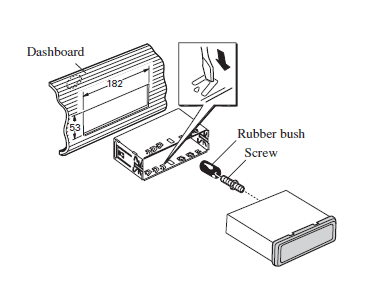
Installation with the rubber bush (Fig. 4)
Holder
After inserting the holder into the dash- board, then select the appropriate tabs according to the thickness of the dash- board material and bend them. (Install as firmly as possible using the top and bottom tabs. To secure, bend the tabs 90 degrees.)
Removing the Unit (Fig. 5) (Fig. 6)
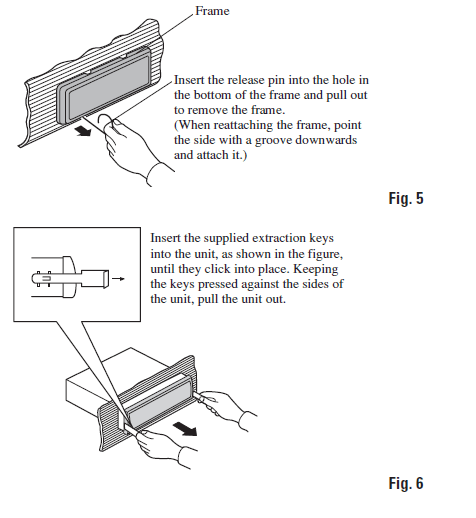
DIN Rear-mount
Installation using the screw holes on the side of the unit
- Remove the frame. (Fig. 7)

- Fastening the unit to the factory radio mounting bracket. (Fig. 8) (Fig. 9)
Select a position where the screw holes of the bracket and the screw holes of the head unit become aligned (are fitted), and tighten the screws at 2 places on each side. Use either truss screws (5 × 8 mm) or flush surface screws (5 × 9 mm), depending on the shape of the screw holes in the bracket.
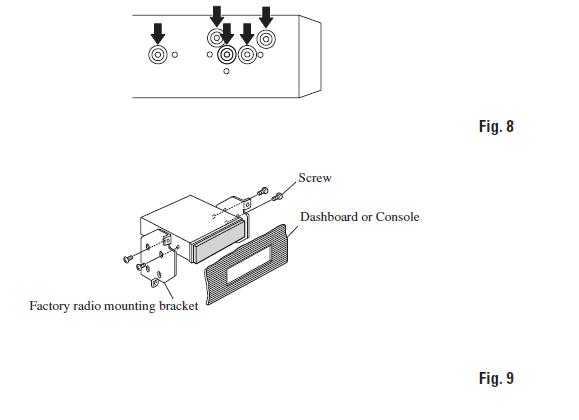
About the fixing screws for the front panel
If you do not operate the Detaching and Replacing the Front Panel Function, use the supplied fixing screws and fix the front panel to this unit.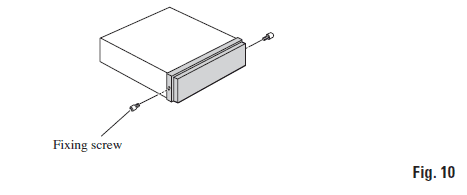
For more manuals by Pioneer visit, ManualsLibraryy
Pioneer DEH-1500 High Power CD Player-FAQs
Can you place a receiver on top of a CD player?
No, avoid placing a receiver or other equipment directly on top of a CD player. Ensure at least 6 inches of open air above the equipment for proper ventilation.
How do I get my CD player to work?
1. Make sure the disc is inserted with the label side up.
2. Clean the disc with a soft, dry cloth.
3. Reinsert the disc and press PLAY.
4. Ensure the HOLD switch, if present, is in the OFF position.
How do I download audio to a CD?
Insert a blank CD into your burner. Use your computer’s media player to drag and drop songs into the burn list, then follow the prompts to burn the CD.
Do I need an amplifier for a CD player?
Yes, some form of amplification is necessary to drive speakers. Many speakers have built-in amplifiers, so a standalone amp may not always be required.
What audio format will play on all CD players?
CD players use the PCM (Pulse Code Modulation) format with a sample rate of 44.1 kHz and 16-bit resolution, as per the Red Book standard.
Which input should I use for a CD player?
Connect your CD player to an amp or receiver using RCA inputs. Look for inputs labeled “CD” for optimal use.
How does a CD player work?
A CD player uses a high-precision laser to read data from the aluminum layer of a CD. The reflected laser beam is analyzed to determine the data position and playback the audio.
How do I reset a CD player?
Unplug the CD player’s power cord for 30 seconds. Plug it back in to reset the device.
How can I check if my CD player is working?
1. Open your computer’s Device Manager.
2. Check for your CD drive and ensure there are no yellow or red marks indicating issues.
How do I burn a CD using a media player?
1. Open Windows Media Player and click the Burn tab.
2. Insert a blank CD into the burner.
3. Add items to the burn list, then click Start Burn.


